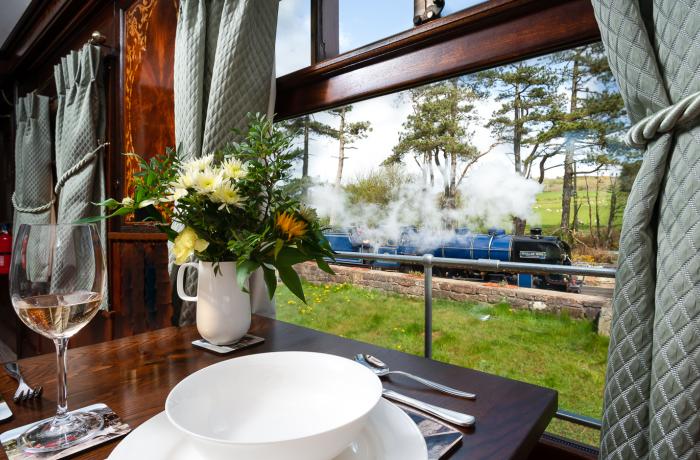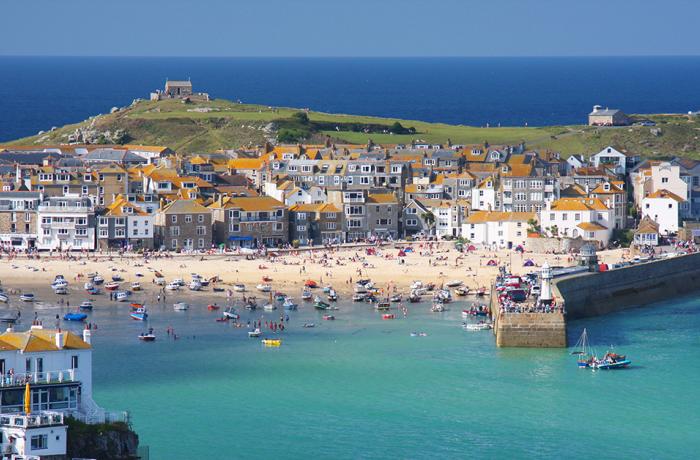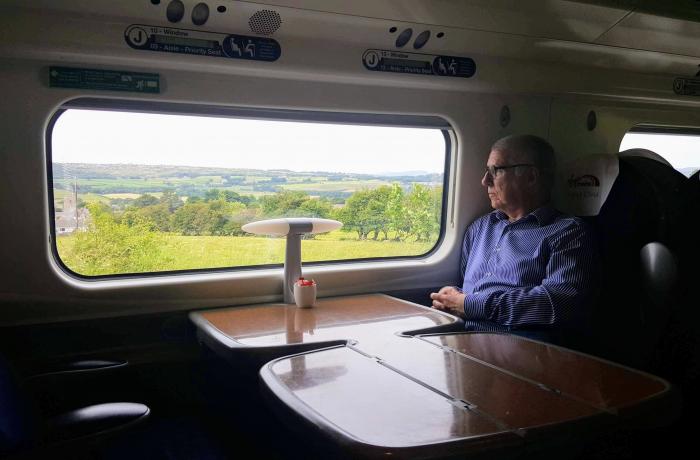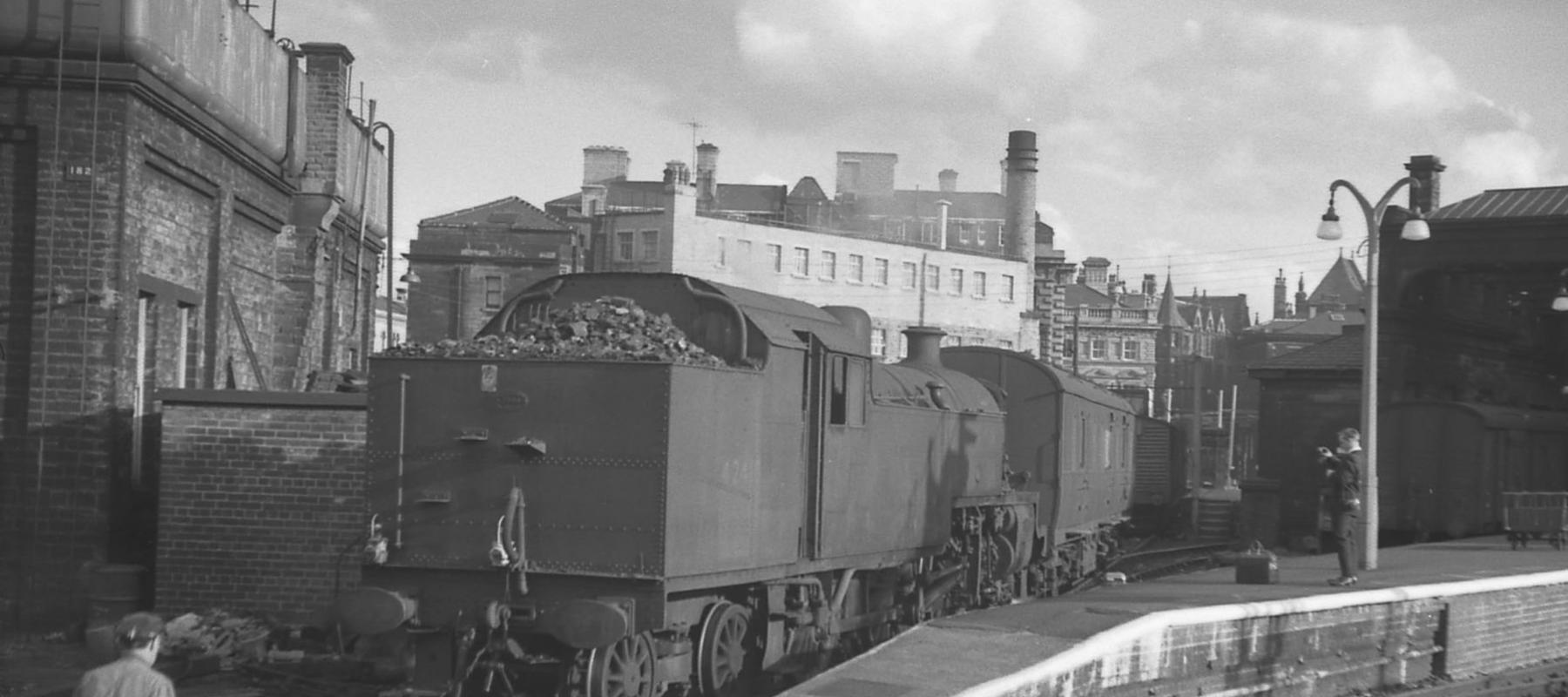
Celebrating railway history
This week sees the return of Heritage Open Days, England's largest festival of history and culture. It's your chance to see hidden places and try out new experiences – all of which are free to explore.
To celebrate the start of Heritage Open Days (9 – 18 September), we asked Professor Paul Salveson to shine a light on the rich and diverse heritage of our headquarters' local station, Huddersfield.
At the end of this blog, we've highlighted some railway-theme events and activities taking place across the country to enjoy this September, as part of Heritage Open Days, so be sure to check them out.
We'd love to hear the stories of your own local station. Share them with us, with pics too, on Twitter, Facebook or Instagram.
Huddersfield Station: one of the best
By guest blogger, Prof. Paul Salveson
Sir John Betjeman called it 'the most splendid station facade in England' and architectural historian Nikolaus Pevsner said it was 'one of the best early railway stations'. Most people in Huddersfield would agree! This article outlines the history of 'our beautiful station' and the people who worked and used it.
Railways came to Huddersfield in the mid-1840s. The Manchester and Leeds Railway by-passed the town, using a route via Brighouse and Mirfield to Normanton. This did not go down well amongst the citizens of Huddersfield, made worse by the comments of a railway official stating that Huddersfield "was not worth stopping a train for."
After much lobbying and campaigning, a bill was passed on April 26th 1845 authorising the building of a railway between Huddersfield and Manchester that would connect with the Manchester and Leeds Railway at Cooper Bridge. The Leeds Mercury for May 3rd 1845 described "a memorable day in the history of Huddersfield and the harbinger of a new and important era in a town of first-rate importance." Church bells were rung and the town celebrated.
The station takes shape
James Pigot Pritchett of York was chosen to design the station; he was a well-known architect of his day. What he produced did full justice to the town, the main portico having Corinthian-style columns setting off well-balanced buildings on either side, housing the Lancashire and Yorkshire (L&YR) and London and North Western Railway (L&NWR) booking offices. The foundation stone was laid on October 9th 1846 and once again the Parish Church did its best to rouse the townspeople from their slumbers, with bell-ringing continuing from the early hours of the morning. A civic procession through the town centre was led off by a band with numerous dignitaries following. The Earl of Fitzwilliam was the guest of honour and he performed the stone-laying ceremony.
Despite the two major celebrations, it was several months more before the first train arrived, on August 3rd 1847, from Cooper Bridge. It was hauled by locomotive 'Aldam', arriving to yet more celebrations and partying. Regular eastbound passenger trains began running from this date, though it was not until 1849 that the line opened to Stalybridge, through Standedge Tunnel. Work on the Penistone Line started in August 1845 but it took five years before the route was completed, with several major viaducts and tunnels having to be constructed. For the first 40 or so years, the station comprised only a long, single platform.
Huddersfield's station buildings were not completed until 1850, in the same year that The George Hotel opened, across St. George's Square.
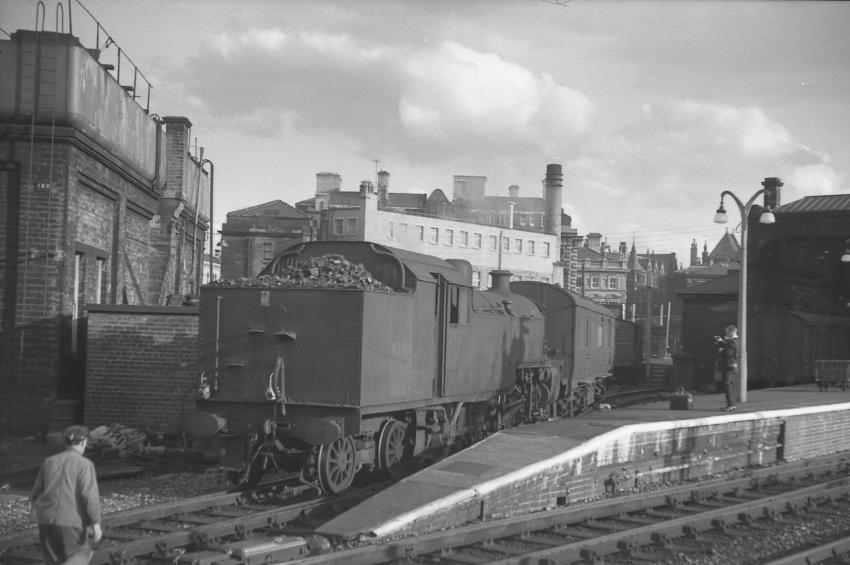
A 'Joint' Station
The station was a 'partnership' before the term was invented. Up to 1922, it was a 'joint station' between the L&YR and the L&NWR. The crests of the two companies are still there, with the L&Y's adorning the buildings on the left, now The Head of Steam with the L&NWR's on the right which now houses The Station Tavern. Station staff wore caps with a badge denoting 'H.J.S.' – Huddersfield Joint Station.
The two companies had their own warehouses, both of which remain, on the far side of the tracks. The L&NWR was responsible for the station's water supply, including supplies for locomotives from both companies. The water tower, at the east end of the station, now houses the offices of Community Rail Network (previously known as Association of Community Rail Partnerships or ACoRP.
In the later years of the nineteenth century, Huddersfield's railways settled down to steady growth. However, not all townspeople were happy with the passenger facilities behind the splendid facade. One irate correspondent to the Huddersfield Examiner complained that 'the platform is promenaded by ladies of easy virtue'. My theory is that they were just interested in trains. In 1871 the station's booking office (we don't know which of the two) was robbed. The culprit turned out to be a railway policeman who was apprehended in Manchester. In the same year the Examiner reported on an excursion train that was delayed owing to a boiler tube bursting. Some of the excursionists 'alighted from the train, and discovering a barrel of kippers, amused themselves by throwing them at each other'. Where was the railway police when you needed them? Probably in jail.
Station extensions
By the early 1880s traffic had long outgrown the single platform and the L&NWR sought parliamentary powers to extend the station. Work was completed in 1886 with new facilities including the large island platform (now platforms 4 and 8) with bay platforms at each end. The extended station included an overall roof. During construction it partially collapsed, killing four workmen.
Huddersfield was served by local trains to Leeds, Manchester, Huddersfield, Bradford and Sheffield, with some longer-distance expresses run by the L&NWR from Liverpool to Newcastle from 1883. The following year, after lobbying by Huddersfield Chamber of Commerce, a direct service to London commenced. It started at Bradford and ran via Huddersfield to Sheffield and Retford. With the opening of the Great Central line to London (Marylebone) in 1899, the train ran via Leicester. It was not until British Railways days that the train was named 'The South Yorkshireman'.
The station remained much 'as was' during twentieth century though the booking office was re-modelled in 1938. There would have been many emotional partings during the two world wars. Probably the busiest day for the station was March 12th 1937 when no less tan 47 extra trains ran for the Arsenal v. Grimsby Town F.A. Cup semi-final match held at Leeds Road ground.
Jack the Station Dog and Other Station Pets
For many years a regular part of station life was 'Jack' the station dog. He carried a collecting tin on his back to raise funds for the railway orphanage and was cared for by the stationmaster Mr. F.W. Brereton, who ran the station between 1911 and 1931. It was the start of a tradition of Huddersfield station pets, continued today by Felix and Bolt the Station Cats.
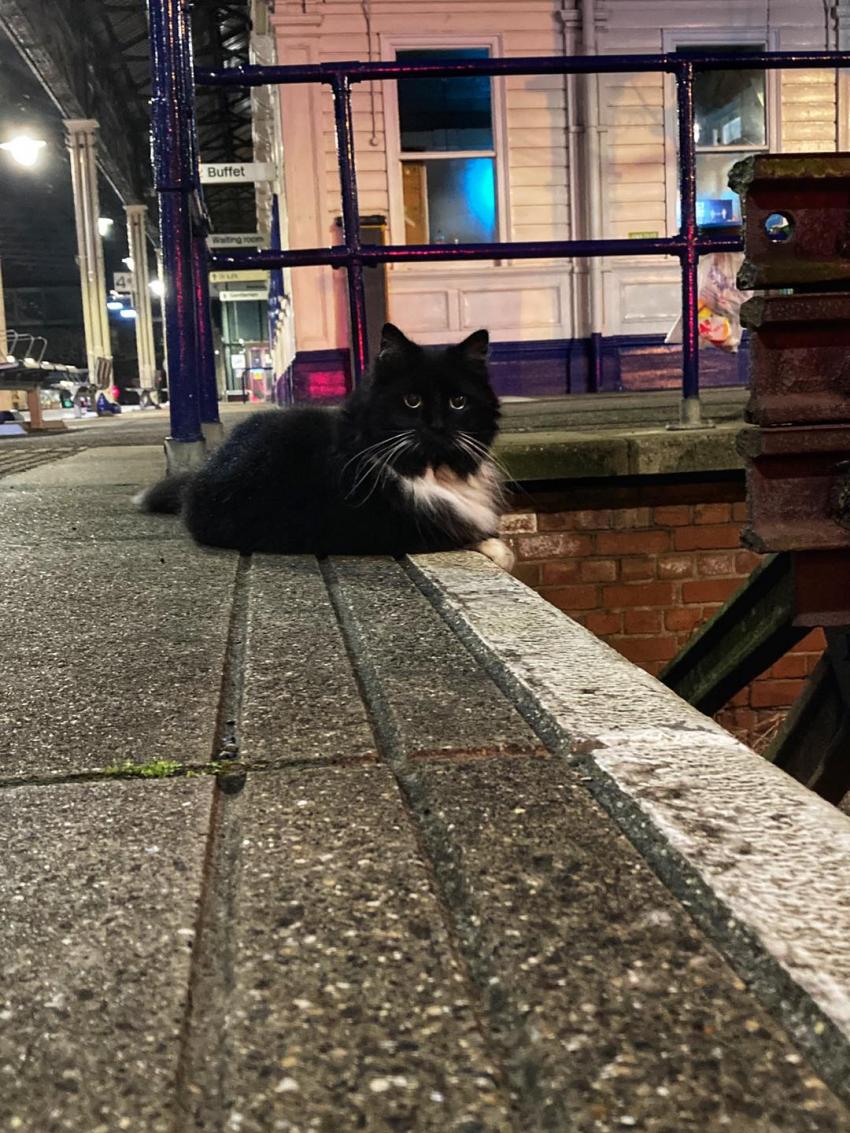
Modernisation and Change
1961 saw the introduction of the Trans-Pennine diesel units between Manchester, Huddersfield, Leeds and Hull. The Newcastle to Liverpool expresses (complete with full restaurant car service) went over to diesel haulage at the same time. Steam continued at Hillhouse sheds until 1967 and the final end of steam came a year later.
The station frontage was bought by Huddersfield Corporation in 1968 to celebrate the borough's centenary. A few years earlier the building had been threatened with demolition and the Corporation, understandably, wanted to make sure that there would no further threats to the town's most iconic building. They paid £52,400 for it and undertook substantial renovations in the succeeding years.
The station was remodelled in 1990 with the creation of a new bay platform for Penistone Line trains. Today's Platform 1 was formally a 'through line' – the platform was extended out over the old trackbed.
Huddersfield station saw the unusual sight of a BR Mark 1 railway carriage being craned into the space next to today's Platform 2, to provide space for a children's nursery. The carriage later became home to the Association of Community Rail Partnerships (now known as Community Rail Network) before they relocated to larger accommodation in the Old Water Tower at the opposite end of the station. The carriage is now used, once again, by the Yorkshire Children's Centre whose main base is in the former L&YR warehouse opposite.
Today, the station is managed by TransPennine Express and served by Northern operating local trains to Sheffield and Bradford.
Community action and development
The Penistone Line Partnership was formed in 1993 to support and promote the Huddersfield – Penistone – Sheffield line which had managed to see off several attempts at closure.
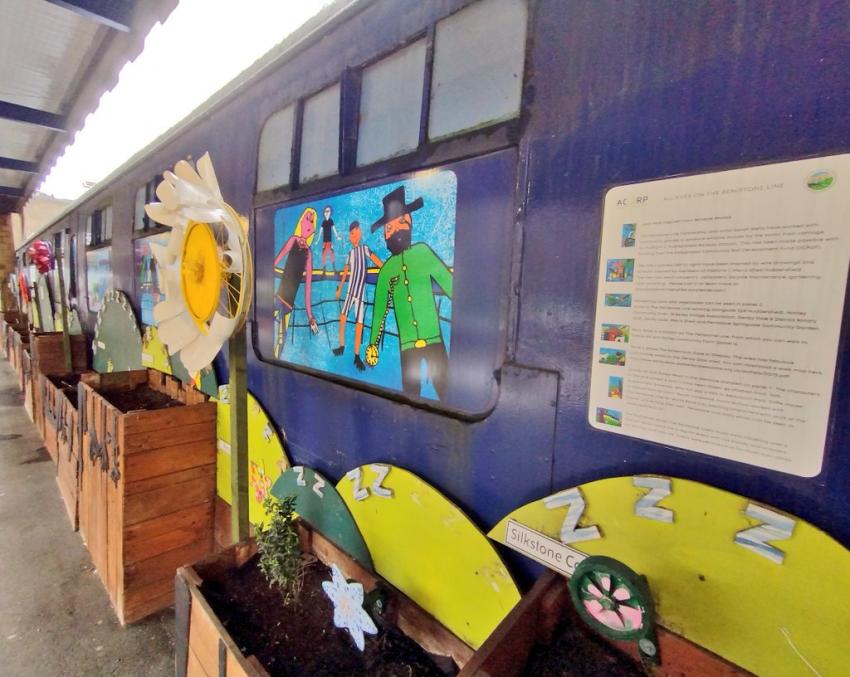
A vigorous campaign by the Rail Users' Association, supported by many local groups, ensured that the plans were dropped, though the line was reduced to a single track as far as Barnsley, with passing loops. One of the most well-publicised initiatives of the Partnership was the 'music trains' which started in September 1993 and proved hugely popular for many years, helped by the availability of hand-drawn real ale.
The Friends of Huddersfield Station was formed in 2011 to promote the station and town and for many years ran a much-appreciated information stand in the station concourse. Geraldine's excellent Station Buffet continues to offer delicious bacon butties and pies on Platform 4/8, with two pubs on Platform 1 and two other catering outlets. TransPennine Express has regular displays of artwork in the waiting areas on Platform 1. Daryl runs the news stall (and coffee point) on Platform 1 offering a great selection of magazines and books.
The Future
Major plans are underway to improve capacity at the station and extend the existing subway to the north side of the station to provide easier access to car parking. In addition, electrification, initially between Leeds and Huddersfield but ultimately to Stalybridge and Manchester, is finally going ahead. Additional track capacity will be provided between Huddersfield and Heaton Lodge Junction (west of Mirfield).
The future looks bright for Huddersfield Station so make sure you save time to visit next time you're travelling through West Yorkshire. You may even catch a glimpse of the famous station cats, Felix and Bolt!
This article is based on Our Beautiful Station: Huddersfield 1847 – 1997, published by TRAIN in 1997.
It is dedicated to the memory of Philip Jenkinson.
About the author
Prof. Paul Salveson
Paul is a visiting professor at the Universities of Bolton and Huddersfield.
His professional life has been split between railways and adult education.

He wrote a pioneering book on the links between Bolton and Walt Whitman - 'Loving Comrades: Lancashire's Links to Walt Whitman' (1984) which was recently republished as 'With Walt Whitman in Bolton: spirituality, sex and socialism in a Northern Mill Town' (2019).
Other published work includes 'Lancashire's Romantic Radical - The Life and Work of Allen Clarke/Teddy Ashton' (2008) and 'Socialism with a Northern Accent' (2012). His most recent publication is 'The Settle-Carlisle Railway' (2019). He is currently working on a novel based on life at Horwich Locomotive Works in the 1970s, where he worked in the Spring Smithy.
Paul is active in Bolton's voluntary sector and chairs the Bolton and South Lancashire Community Rail Partnership. His PhD was 'Region, Class Culture: Lancashire Dialect Literature 1746-1935' (University of Salford 1993).
Railway-themed events & activities
Explore fascinating railway history and learn new things this Heritage Open Days. See below for exciting events and activities hosted by some of our community rail friends.
Huddersfield Station Heritage
17 & 18 September
Peek behind closed doors as you take a guided tour of Huddersfield Station and learn more about its fascinating 175-year history as part of Heritage Open Days.
Find out more
Lowestoft Heritage Festival
From 9 September
Lowestoft's Community Rail Shop and Tourist Information Office, located at the town's railway station, will be home to the Festival Information Hub boasting an array of events and providing information to visitors about festival activities. Events at the station will include:
Music @ Parcels Office – Buffalo Bill Comes to Lowestoft – 9 September
ENIGMA – The scrambled messages of WWII and beyond – 10 & 11 September
Lowestoft at War exhibition – 10 & 11 September
Protecting Lowestoft from future flooding exhibition – 14 September
Sail, Steam & Diesel exhibition – 15 & 16 September
Somerleyton Railway Swing Bridge Tour
10 September
A highlight of the Lowestoft Heritage Festival (see above) this event provides a unique opportunity to visit the 1905-build Somerleyton Railway Swing Bridge. Find out more
Hunmanby Heritage Day
10 September
Discover the history behind this award-winning railway station, providing a gateway to the picturesque village of Hunmanby.
Find out more
Leamington Station
10 & 18 September
Enjoy a guided tour of Leamington's award-winning station gardens together with the public areas of the restored Grade II listed Art Deco buildings.
Find out more
Ridgmont Station Heritage Centre
9-11, 14-18 September
Explore this award-winning Victorian station house restoration with its original booking office, station master's parlour, vintage tea room & more.
Find out more
Bat & Ball Station
17 September
Head to the Station for cream tea with Queen Victoria, arts & crafts, and delicious themed refreshments! Visit Bat & Ball Community Centre for train-themed adventures before hopping onto a vintage bus heading to Swanley Park for more fun.
Find out more
People's Museum & Railway Heritage Trail
12-18 September
Step back in time as you explore fascinating displays full of old photographs and memorabilia gathered from around Bishop Auckland. Don't forget to pick up a copy of the self-guided Railway Heritage Trail to learn more about the area's rich railway history.
Find out more
Liskeard Unlocked – Virtual Tour of Liskeard Station Signal Box
From 9 September
Explore the historic signal box from the comfort of your own home.
Find out more
Liskeard Unlocked – The Driver's Eye View of the Looe Valley Line
From 9 September
Experience what it's like to be in the train driver's seat as you travel along the scenic Looe Valley Line.
Find out more
Subscribe to our blog posts. We are planning to post about once a month. We will never share your details and you can unsubscribe with a single click.


